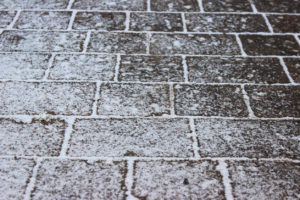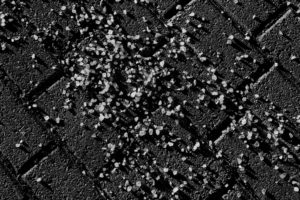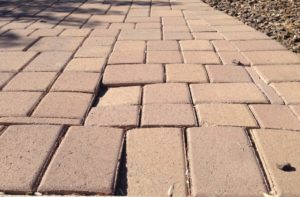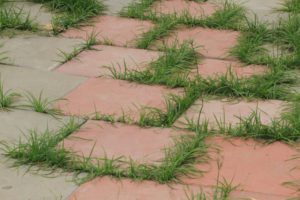
How did the winter affect your patio and interlock stone?
Hopefully, you prepared your landscaping for winter by doing things like:
- Applying lawn care fertilizer to develop the grass for the cold weather
- Kept up your grass cutting for as long as possible
- Cleaned your gutters and eavestrough in preparation for excess moisture and water
- Pulled out stubborn weeds that can survive under harsh winter conditions
- And protected your interlock backyard patio stones
But even if you did all of those things to prepare your yard, chances are the winter still left it a bit of a mess. Pavers and interlock stone need extra love and care throughout the cold and wet winter, and while you cleaned your interlocking pavers and topped them up with polymeric sand, they’ve still been exposed to the worst Old Man Winter throws at it.
While you’re warm and cozy inside, here’s what your natural stone and interlock pavers have had to deal with being out in the cold.
Corrosion from salt and ice
Like many Canadian homeowners, you probably use ice melt or rock salt for snow removal or ice management. Doing so makes it safer and more comfortable for you to navigate your driveway and front entrance walkways.
The flip side is that it can harm your interlock pavers in a variety of ways:
- Permanent stains or discolouration
- Weakening the strength or integrity of the stones
- Getting stuck in cracks or crevices
- Loosen them from the aggregate base underneath
At Wright Landscape Services, we’ve found the reason this happens to interlocking pavers is that people use more salt products than they really need.
Stone instability from water runoff and drainage
If you installed the interlocking stones in your landscape design yourself (vs. having a
professional landscaping contractor do it), you won’t be able to tell if your pavers have shifted until winter ends and spring arrives.
Here’s why:
- Underneath the stones, the aggregate base isn’t smooth or flat
- As snow melts (especially on warm winter days), it drains below the pavers and erodes the underlying soil and aggregate
- The more water trapped below the stones, the more they get pushed up
- If a cold snap hits, that trapped water freezes and dislodges the stones even more
If your patio stones have suffered some instability, the best-case scenario is to reapply the aggregate-base and settle the stones back into place. The worst-case scenario? The stones have become cracked or completely damaged and need to be replaced. While you can do this on your own, it might be a good idea to call in a professional. Our design & build services help install beautiful and functional patio features that can stand up to harsh winters.
Mossy growth
When you last saw your stones (before winter arrived in full force), they were bright, clean, and clear.
Imagine the shock you’ll receive when spring comes around and your interlocking patio or driveway is covered in green moss.
During winter, moss can form on your patio stones, especially if they’re:
- Underneath bushes
- Located in a shady area
Shade, plus the natural moisture of snow and ice, can lead to moss forming on your stones.
If you beautified your yard before winter by pruning any low-hanging branches or overgrown shrubs, you’ve greatly minimized the chances of moss growth.
If you haven’t, you could do a quick trim job now. Just be careful you don’t shock or damage your trees and bushes but trimming them too soon and if there’s still water and ice, make sure you are wary of potential slip and fall hazards.
Wobbly flagstone
Wobbly flagstone can happen when your stones shift and move over time. To explain this phenomenon, we need to understand a little bit about the science of heat and cold on rock and stone.
- Heat causes expansion
- Cold causes contraction
The freeze/thaw cycle mentioned earlier in this blog can impact flagstone steps and retaining walls. The temperature changes don’t need to be dramatic one way or the other for this to occur.
Shaky or wobbly flagstone looks bad and also poses a trip-and-fall risk (especially for kids). If possible, try to keep your flagstone areas free and clear of ice throughout the winter.
When spring arrives, you should consider removing your flagstone (even if it appears to be undamaged by winter) and reinstalling them with a mortar compound. That way, your flagstone will shift less dramatically and stay in place.
We can help restore your interlocking pavers this spring
If you’re concerned that your patio and interlock stones took a beating this winter, we’d love to help you out. We’re experts at designing beautiful and liveable outdoor spaces you’ll love. Wright Landscapes team of designers, architects, and landscapers make sure that your yard is safe, beautiful and functional.
Contact us today and ask for a FREE quote to find out how you can update your yard, and create an outdoor living space you’ll love.

Need inspiration?
When you start to think about designing the perfect yard, deck, patio or backyard oasis, it can be helpful to have some solid ideas of what you want to achieve. We can help with that.




